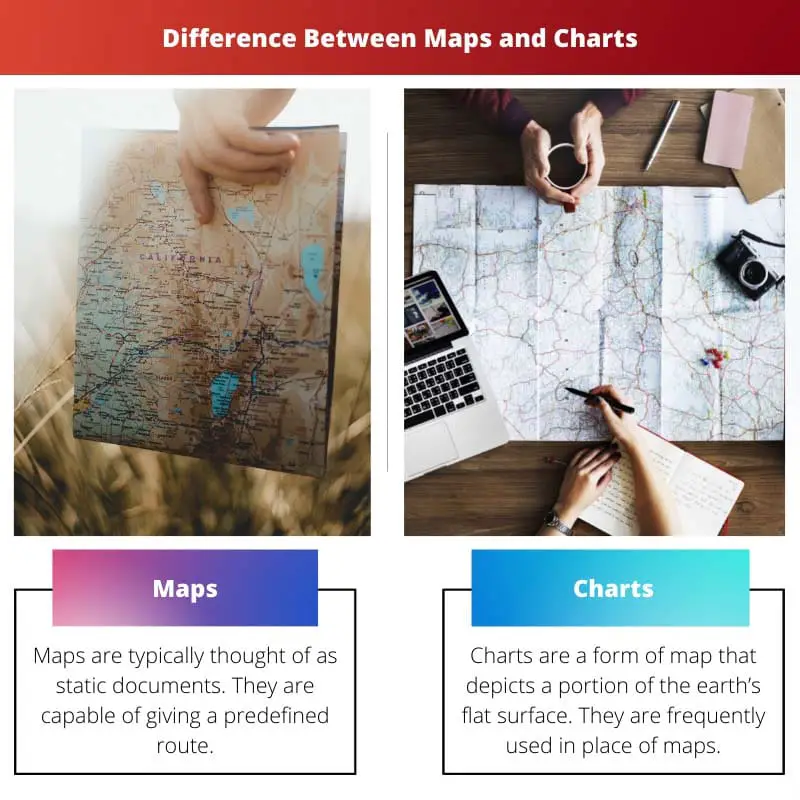Maps and charts come in a variety of styles. Some are used to identify geographical areas, while others are used to identify political and social zones.
Scales are used on certain maps, although they are not used on others. Cartographers are among the technicians who use maps and charts to collect primary and secondary data on the Earth and its surface.
Cartographers are experts in the creation of a wide range of maps.
Key Takeaways
- Maps represent geographical features on a flat surface, while charts represent various types of data and information.
- Maps are used for navigation and understanding spatial relationships, while charts help visualize data trends, comparisons, and relationships.
- Cartographers create maps, whereas statisticians, data analysts, and graphic designers create charts.
Maps vs Charts
A map is a graphical representation of any geographical location on a piece of paper or sheet. Water shapes and tidal levels can be depicted on charts. Because charts can provide additional information, they are frequently used to portray oceanic designations. Most people think of maps as static documents.

They can offer a preset course. Maps can’t tell you about the path’s current state. They can only provide information about the surface path, though.
Maps depict information in the form of spherical and celestial representations. Maps are unable to provide all of the necessary details for navigation.
When it comes to geographical designations that depict land shapes related to sea level, the usage of maps is very clear.
A chart is a form of map that depicts a portion of the earth’s flat surface. They’re frequently used as a map replacement. Charts are documents that function in a specific way.
They also supply data for navigational charts and plot the entire journey. Charts contain all of the necessary precise and detailed information for navigation.
Hydrographic charts, known as historical charts, provide information in the form of tables.
Comparison Table
| Parameters of Comparison | Maps | Charts |
|---|---|---|
| Type of Document | Static | Working |
| Use in navigation | Can be used | Can not be used |
| Designation focus | Geographical designation | Oceanic designation |
| Representation: Form | Spherical celestial | Tabular |
| Condition | Does not give information related to conditions. | Gives information regarding the condition. |
What are Maps?
Maps are thought of as static documents. They are capable of giving a predefined route. Maps are unable to provide information about the path’s current status.
However, they can only provide information on the course of the surface.
Maps depict information in the form of spherical and celestial representations, which can take numerous forms, such as travel maps, survey maps, and maps of a country, state, city, or town.
A map represents a geographic location, a series of events, activities, nations, or states on a piece of paper or sheet.
Maps are unable to convey all of the specific information essential for navigation.
When considering the geographical designations that depict the land shapes connected with the sea level, the use of maps is very clear. The Coast Survey charts of the United States are an example of a map.

What are Charts?
Charts are a form of map that depicts a portion of the earth’s flat surface. They are frequently used in place of maps. Charts are regarded as texts that function in a specific way.
They also supply information for navigation charts as well as plotting the full voyage.
Charts contain all of the necessary thorough and accurate information for navigational purposes. Water forms and tide levels are examples of conditions that can be represented using charts.
The usage of charts is obvious when portraying oceanic identification because they can provide additional information.
In the case of charts, the data is presented in the form of tables (otherwise called tabular form).
The information on hydrographic charts, also known as historical charts, is presented in the form of tablets, which mariners commonly use.

Main Differences Between Maps and Charts
- A map represents any geographical area, series of events, acts, nations, or states on a piece of paper or sheet. On the other hand, Charts are the subtype of maps representing a part of the flat surface of the earth. They are used as substitutes for maps.
- The information that is being portrayed by maps is in the form of spherical and celestial representations, which can be of many types, including journey maps, survey maps, and maps of a country, state, city, or town. On the other hand, in the case of charts, the information provided is portrayed in tables (otherwise called tabular form). In the case of hydrographic charts or historical charts, the information is also portrayed in the form of tables, which seamen use.
- The use of maps is highly evident while considering the geographical designations which portray the landforms associated with the sea level. On the other hand, charts are highly evident while representing the oceanic designation, as they can provide extra information.
- Maps can not provide all the detailed information which are required for navigation purposes. On the other hand, Charts possess all the required detailed and accurate information which can be used for navigation purposes.
- Maps are not capable of providing information regarding the conditions of the path. However, they are only capable of providing data regarding the surface path. On the other hand, Charts are capable of providing information related to conditions like water forms and tidal levels.
- Maps are considered as documents that are static in characteristics. They are capable of providing a course that is predetermined. On the other hand, Charts are considered aa documents that are working in characteristic. They also provide information that is helpful for navigation charts and also plots the entire journey.
- Some examples of Maps are the Coast Survey charts of the United States. On the other hand, some examples of Charts are the representation of tidal levels, water bodies, etc.





